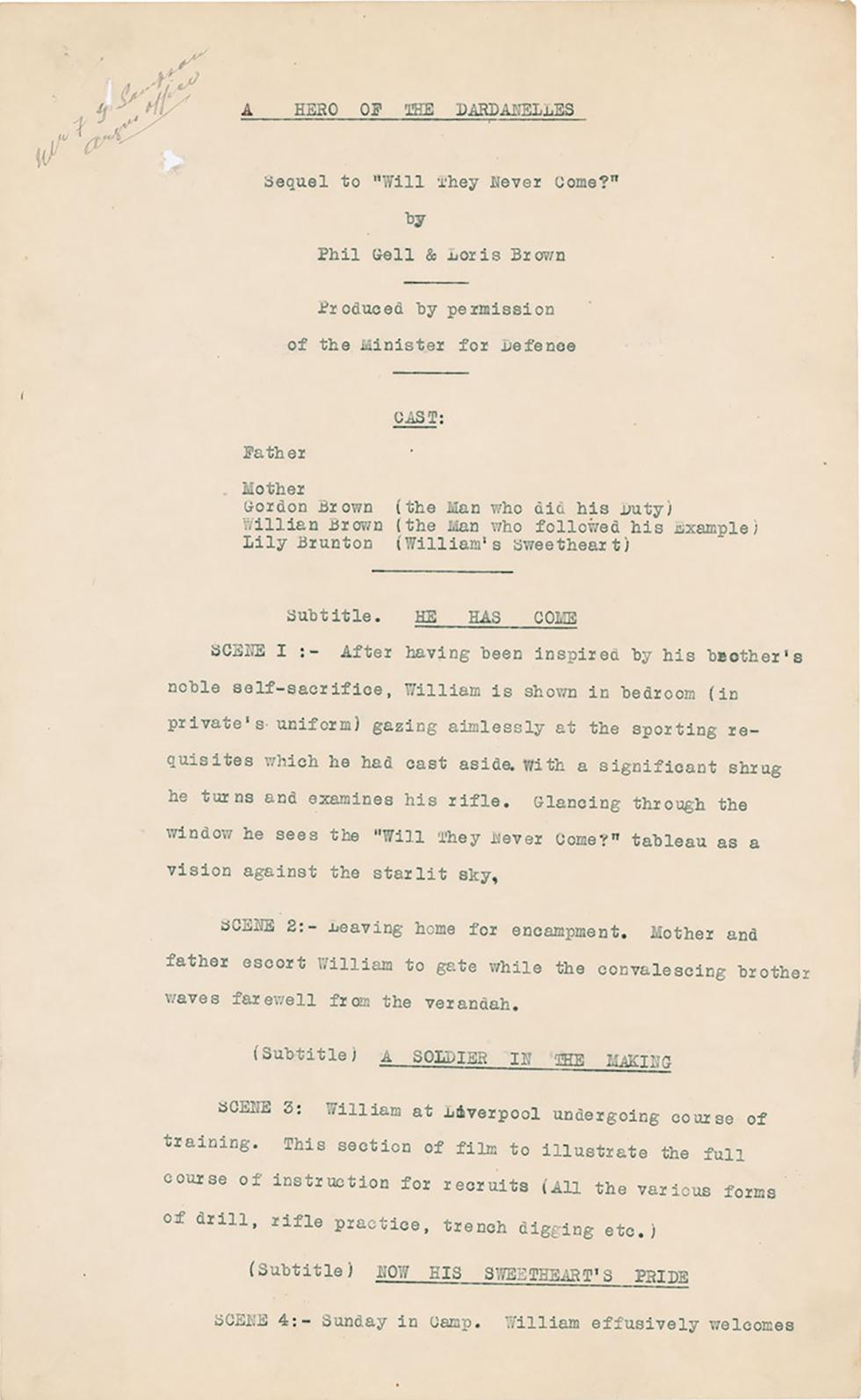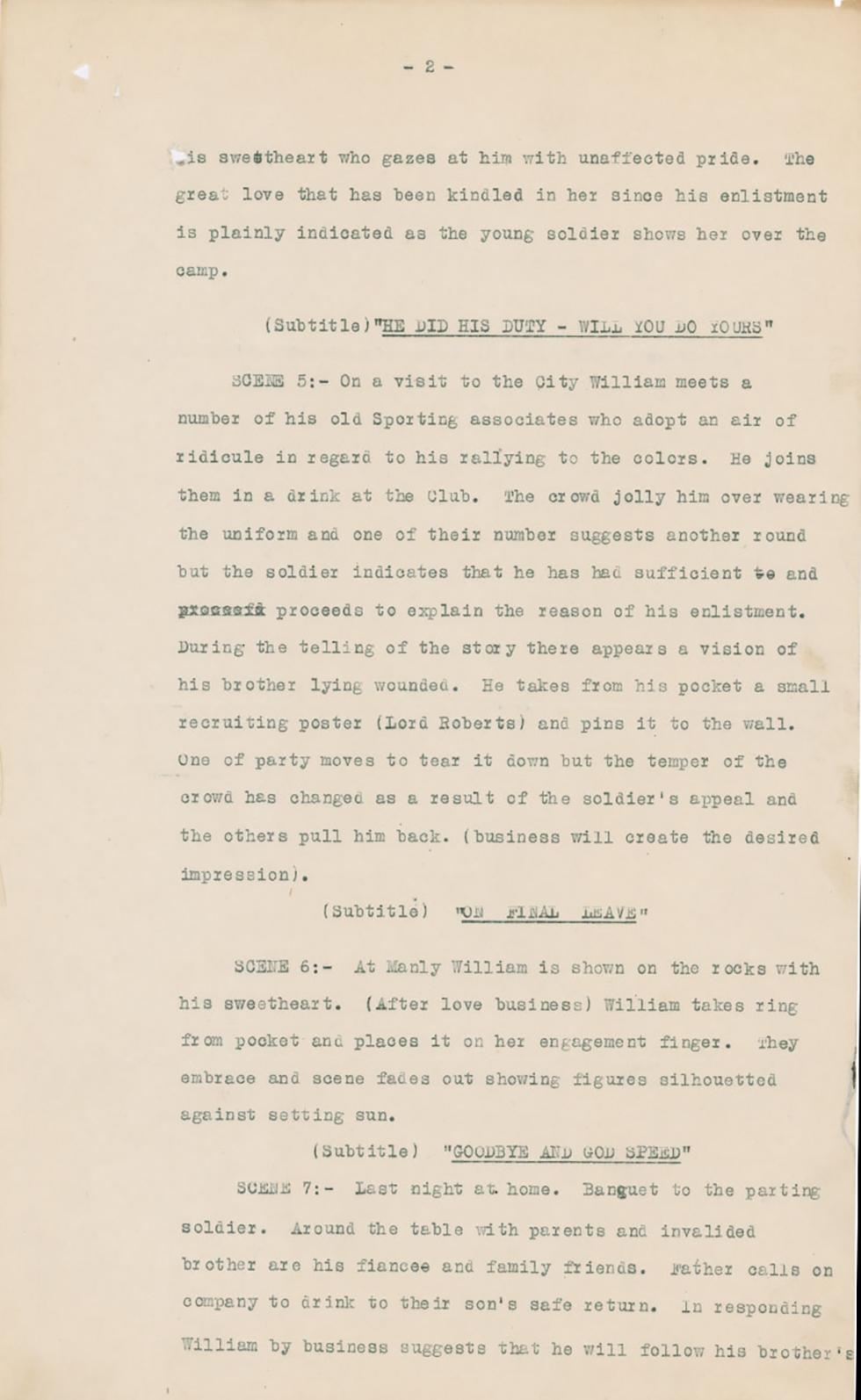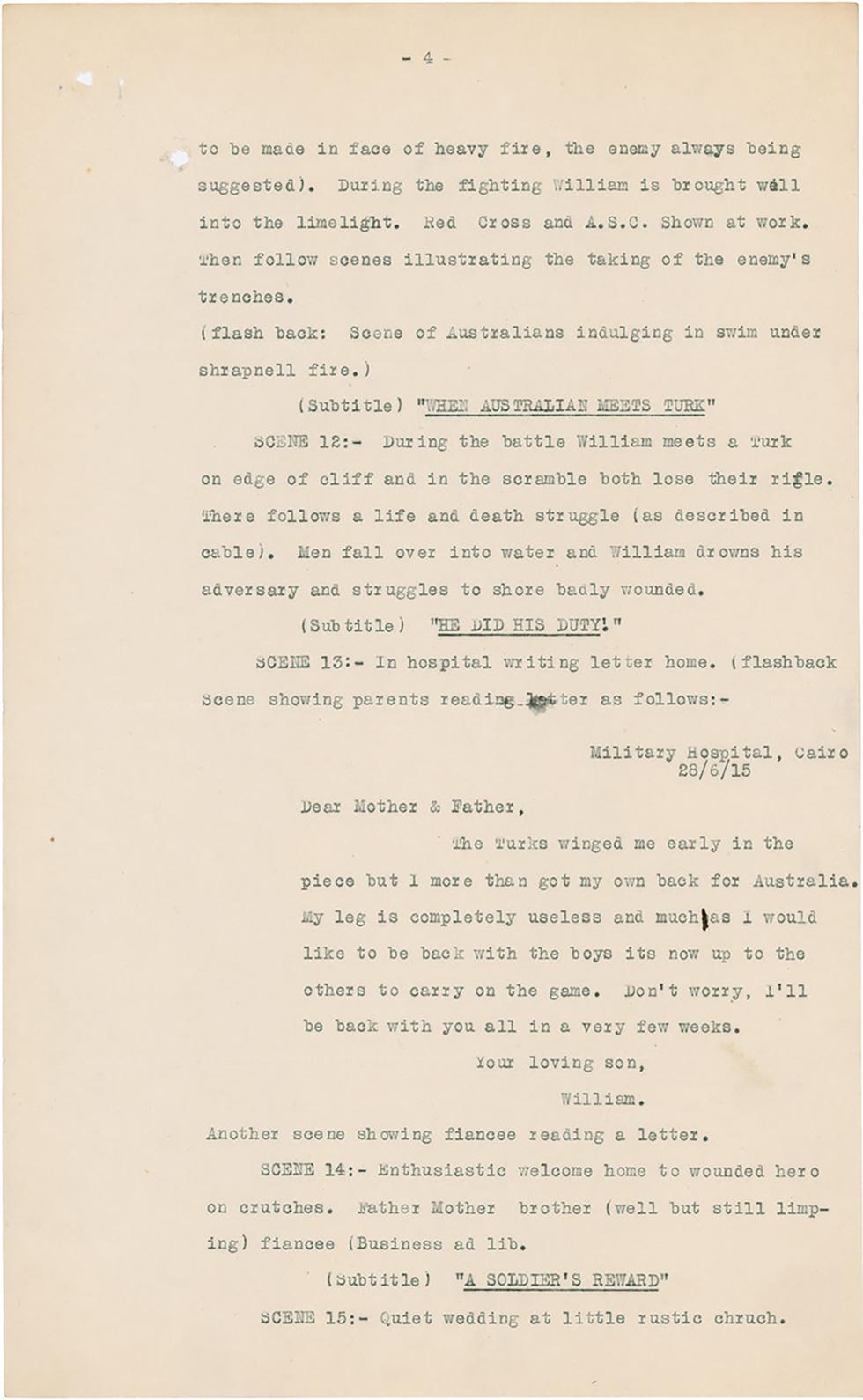



Aboriginal and Torres Strait Islander people should be aware that the National Archives' website and collection contain the names, images and voices of people who have died.
Some records include terms and views that are not appropriate today. They reflect the period in which they were created and are not the views of the National Archives.





[Handwritten note in the top left corner of the page] Mr F G Sampson Argus Office
[Underlined heading] A HERO OF THE DARDANELLES
Sequel to "Will They Never Come?"
by
Phil Gell & Loris Brown
[dividing line.]
Produced by permission
of the Minister for Defence
[dividing line.]
CAST: [underlined]
Father
Mother
Gordon Brown (the Man who did his Duty)
William Brown (the Man who followed his Example)
Lily Brunton (William’s Sweetheart)
[dividing line.]
Subtitle. HE HAS COME [underlined]
SCENE 1: - After having been inspired by his brother's noble self-sacrifice, William is shown in bedroom (in private's uniform) gazing aimlessly at the sporting requisites which he had cast aside. With a significant shrug he turns and examines his rifle. Glancing through the window he sees the "Will They Never Come?" tableau as a vision against starlit sky,
SCENE 2: - Leaving home for encampment. Mother and father escort William to gate while the convalescing brother waves farewell from the verandah [sic].
(Subtitle) A SOLDIER IN THE MAKING [underlined]
SCENE 3: William at Liverpool undergoing course of training. This section of film to illustrate the full course of instruction for recruits (All the various forms of drill, rifle practice, trench digging etc.)
(Subtitle) NOW HIS SWEETHEART’S PRIDE [underlined]
SCENE 4: - Sunday in camp. William effusively welcomes
[Page] -2-
his sweetheart who gazes at him with unaffected pride. The great love that has been kindled in her since his enlistment is plainly indicated as the young soldier shows her over the camp.
(Subtitle) "HE DID HIS DUTY – WILL YOU DO YOURS" [underlined]
SCENE 5: - On a visit to the City William meets a number of his old Sporting associated who adopt an air of ridicule in regard to his rallying to the colors [sic]. He joins them in a drink at the Club. The crowd jolly him over wearing the uniform and one of their number suggest another round by the soldier indicates that he has had sufficient to [crossed out] and proceefd [sic - crossed out] proceeds to explain the reason of his enlistment. During the telling of the story there appears a vision of his brother lying wounded. He takes from his pocket a small recruiting poster (Lord Roberts) and pins it to the wall. One of the party moves to tear it down but the temper of the crowd has changed as a result of the soldier’s appeal and the others pull him back. (business will create the desired impression).
(Subtitle) "ON FINAL LEAVE" [underlined]
SCENE 6: - At Manly William is shown on the rocks with his sweetheart. (After love business) William takes ring from pocket and places it on her engagement finger. They embrace and scene fades out showing figures silhouetted against setting sun.
(Subtitle) "GOODBYE AND GOD SPEED" [underlined]
SCENE 7: - Last night at home. Banquet to the parting soldier. Around the table with parents and invalided brother are his fiancée and family friends. Father calls on company to drink to their son’s safe return. In responding William by business suggests that he will follow his brother’s
[Page] -3-
noble example. Scenes concludeswith [sic] soldier leaving home (night effect) Mother seems to give way but father and the boy's sweetheart cheer her up.
(Subtitle) "FOR KING FOR COUNTRY" [underlined]
SCENE 8: - Scene in camp, packing up Kit &c [etcetera], embarking on train. On the transport at Sea. Next [crossed out and handwritten inscription ‘Night’] time William peering over rail (flash back short scene) Mother and Sweetheart shown at prayer.
(Subtitle) "FOR THE DARDANELLES" [underlined]
SCENE 9: - Scene showing William in camp in Egypt (show only few bell tents and then a panorama of camp [hand drawn parenthesis] – this can be obtained from negative taken for us by Pathe Freres [hand drawn close parenthesis]. There is a stir in the camp when a soldier rushes up to William’s tent with the [illegible, crossed out] news that the Australians have been ordered in the Dardanelles.
(Note) --- All scenes at Dardanelles to be produced according to Ashmead Bartlett’s report. [Hand drawn box inscribed around note]
(Subtitle) "THE LANDING AT GALLIPOLI" [underlined]
SCENE 10: -- On the transport. Men waiting on deck prior to embarking in boats. Officers examining kit &c (according to military custom) Men shown coming down gangway [handwritten] to [end handwritten] naval cutters manned by bluejackets. Boats being towed ashore by pinnaces. (flash back close view of gunners loading and firing. This can be made from stock negatives and will suggest navy covering landing) On the way to the shore the men discover magazines empty and with a grim determination fix bayonets. Nearing the beach bullets from the enemy splash all around boats and several fall.
(Subtitle) "AUSTRALIA FOREVER" [underlined]
SCENE 11: - Men jump from boats into water up to their necks and storm the heights. Driven back they charge and charge again until finally the position is won. (charges
[Page] -4-
to be made in face of heavy fire, the enemy always being suggested). During the fighting William is brought well into limelight. Red Cross and A.S.C. [Army Service Corps] Shown at work. Then follow scenes illustrating the taking of the enemy’s trenches.
(flash back: Scene of Australians indulging in swim under shrapnell [sic] fire.)
(Subtitle) "WHEN AUSTRALIAN MEETS TURK" [underlined]
SCENE 12: - During the battle William meets a Turk on edge of cliff and in the scramble both lose their rifle. There follows a life and death struggle (as described in cable). Men fall over into water and William drowns his adversary and struggles to shore badly wounded.
(Subtitle) "HE DID HIS DUTY!" [underlined]
SCENE 13: - In hospital writing letter home. (flashback scene showing parents reading letter as follows: -
Military Hospital, Cairo
28/6/15
Dear Mother & Father,
The Turks winged me early in the piece but I more than got my own back for Australia. My leg is completely useless and much [hand drawn line] as I would like to be back with the boys its [sic] now up to the others to carry on the game. Don’t worry, I’ll back with you all in a very few weeks.
Your loving son,
William.
[end letter]
Another scene showing fiancee [sic] reading a letter.
SCENE 14: - Enthusiastic welcome home to wounded hero on crutches. Father Mother brother (well but still limping) fiancee [sic] (Business ad lib.
(Subtitle) "A SOLDIER'S REWARD" [underlined]
SCENE 15: - Quiet wedding at little rustic church.
This five-page script was written in 1915 by Phil Gell and Loris Brown for a proposed Australian recruitment film titled A Hero of the Dardanelles. Created by Amalgamated Pictures Limited, the film was intended as a sequel to Will They Never Come? which was also made in 1915. The script includes the cast of characters and describes the action and setting for 15 scenes. It tells the story of a young man who leaves his family and sweetheart to enlist in the Australian Imperial Force (AIF) and then serves at Gallipoli.
Learn how to interpret primary sources, use our collection and more.
